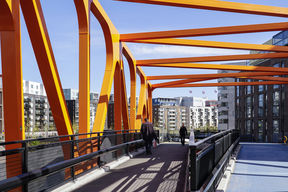Doctoral study: Walkable environments and green spaces can help get sedentary older adults moving

Walking is one of the most common forms of physical activity among older adults and a way for maintaining good health. According to spatial planning researcher Tiina Laatikainen, there is more to it than encouraging people to lace up their jogging shoes – urban planning can play central role in supporting everyday physical activity.
In her doctoral dissertation, due to be examined at Aalto University, Laatikainen proposes that dense, walkable and green urban environments can spur older adults to everyday physical activity, even if they are not especially interested in exercise otherwise. Environmental factors were also shown to have a stronger link to walking than individuals' income levels, education or perceived health. The study was conducted among 55–75-year-olds living in the Helsinki Metropolitan Area.
'Neighbourhoods that are seen as pleasant and walkable can even get a couch potato moving,' says Laatikainen.
The Finnish population is one of the oldest in Europe. Physical inactivity, obesity and other lifestyle-related diseases are becoming more widespread all around the world.
'Living in one's own home for as long as possible is not only the wish of many ageing people, but a political goal as well. To maintain their health and wellbeing, it is important for all kinds of people to be able to move outdoors and be physically active in their local environments,' Laatikainen says.
The study used a digital participatory mapping method to survey the everyday physical activity of people of different ages. Participants used the map to mark down their everyday locations and places they considered quality environments. They also listed their interests and goals, which included maintaining physically active.
What kinds of urban environments encourage everyday activity among people?
- Dense city structure with good walking routes
A dense urban environment with a functional network of walking routes promotes moving around on foot. - Green spaces and waters
Quality environments motivate people to leave their houses. Older adults perceived nearby green and blue spaces as quality environments, whereas children and young people, for example, tend to favour schoolyards and sports facilities. - Convenient public transport connections
Areas with efficient public transport service are directly connected to how much walking is done there. Walking to transit stops and stations is better for health when compared with the alternatives of being sedentary or driving.
According to Laatikainen, Helsinki is a positive example of an age-friendly city that promotes everyday physical activity. The promotion of everyday activity through urban planning is also noted in the city's strategy.
'Jätkäsaari, for example, is densely built, but the residential area will in the future also be characterized by a large green space, Länsisatamanpuisto Park. The park includes a thoroughfare for pedestrian and bicycle traffic, making it possible to travel all the way up to Ruoholahti on foot, bike or wheelchair,' Laatikainen says.
Tiina Laatikainen's doctoral dissertation "Environments for Healthy and Active Ageing" will be examined at the Department of Built Environment of the Aalto University School of Engineering on 17 May 2019 at 12.00. The field of the dissertation is spatial planning and transportation engineering.
Read more news

Seizing opportunities
Vuong Vo's path led through Aalto University and VTT to a startup, where he is helping build the protein factory of the future.Growing Materials, Growing Ideas: Inside the BioMaker Studio
At Aalto University’s BioMaker Studio, initiated by Ena Naito, students and researchers experiment with living materials, from algae to mycelium, creating an open, interdisciplinary space where design, biology, and collaboration grow together.
Your voice gives away valuable personal information, so how do you keep that data safe?
With speech technologies becoming increasingly common, researchers want to make sure we don’t give away more information than we mean to.






